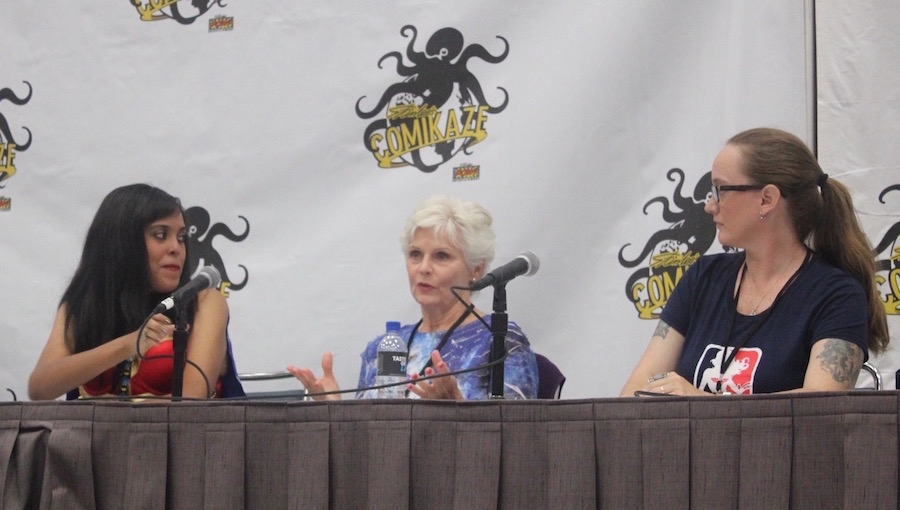It was 75 years ago that Wonder Woman first appeared in the December 1941 All-Star Comics #8 as an 8-page story. The warrior princess was created and written by William Moulton Marston, while artist H.G. Peter brought her to life visually. She is a founding member of the Justice League and has most recently been honored in the real world a couple of weeks ago with a UN Honorary Ambassador for the Empowerment of Women and Girls. And, at Stan Lee’s Los Angeles Comic Con last weekend, she was the subject of multiple panels, including “Wonder Woman 75: A Retrospect of an Icon,” moderated by Londyn Jackson, who was appropriately attired in a Wonder Woman costume. Joining Jackson were Shannon Farnon (voiced Wonder Woman on Hanna-Barbera’s Super Friends), Cat Staggs (artist, Wonder Woman ’77), Marc Andreyko (writer, Wonder Woman ’77), Susan Eisenberg (voiced Wonder Woman on Cartoon Networks’ Justice League and Justice League Unlimited), Christie Marston (granddaughter of William Moulton Marston), and Albert Ching (Managing Editor, Comic Book Resources).
Jackson began the hour by asking her panelists to encapsulate Wonder Woman in one word. “Bold,” “Potential,” “Compassion,” “Heroic,” and “Iconic” were brought up while Farnon described the superhero as “cooperating with the entire world.” Given Wonder Woman’s recent United Nation’s honor, as well as being commemorated on the USPS Forever Stamps, Jackson asked the panelists to share their opinions for why they thought that Wonder Woman had recently returned as a mainstay of popular culture. Farnon stated that “she’s due” while Andreyko explained that given the rise of geek culture, he felt that “girls are loyal followers.” Eisenberg agreed, saying that fandoms have been very helpful in promoting Wonder Woman. Marston echoed Farnon by agreeing that it was about time, but she also explained that the societal climate in which Wonder Woman was first introduced to readers is not dissimilar to today.
Why is Wonder Woman an enduring superhero? Marston stated that actress Lynda Carter was hired to portray the superhero as she was originally written. Hence, the character was founded on decades of material. Andreyko said that Wonder Woman was inclusive, an inspiration, and was molded from love, not tragedy. He added, “Everyone wants to be their best around her.” She also strives to solve problems without resorting to violence. For Farnon, who grew up with Wonder Woman in comics, she revealed that there just wasn’t any other women in comics for girls to look to as role models.

Jackson segued a few specific questions to Farnon regarding her experience voicing Wonder Woman. Farnon talked about working with the director to develop a voice for the superhero. She also felt she worked with some amazing actors who provided the voices for some of the other Justice League characters. Warmly, she expressed how much she enjoyed the work and how memorable it had been.
Andreyko and Staggs are currently working on Wonder Woman ‘77 and both were anxious to work on the title. In preparation for the comic book series, they each admitted to binge watching the Carter series. They did mention they will be working on a Batman ‘66 vs. Wonder Woman ‘77 six-issue series which will feature an Alex Ross variant cover. Andreyko discussed how Carter had been a “torchbearer for an amazing forty years” and hence, he felt he had a sense of responsibility to Carter. Staggs described that the driving vision of Wonder Woman is that she “should be able to walk into a room and command attention with her presence.” Visually, Staggs gave the superhero muscle tone yet she has kept her femininity.
Eisenberg, who voiced Wonder Woman for the animated series on Cartoon Network, revealed that she “didn’t think at time that [she] was bringing Wonder Woman back” for a newer generation to learn about and appreciate. It wasn’t until after the shows were ended that Eisenberg experienced positive reactions from fans, leading her to fully realize the impact of the shows.
Jackson asked each panelist their first memory of Wonder Woman. Ching said it was the Carter television show, as well as seeing the iconography of the character. Marston remembered being about three years old and reading the Wonder Woman comics in the original bound books. Eisenberg, like Ching, cited the Carter series, but she added that it was also during a Warner Brothers’ meeting with Bruce Timm and getting to see a drawing of her character. Andreyko stated it was the Super Friends cartoon and the Carter series. Staggs said her memory was a blending of Super Friends, the Carter series, and the comics. Farnon stated it was the DC Comics as well as paper dolls – a concept she had to explain to some of the panelists and audience members.
Jackson asked the panelists their thoughts about the new filmic Wonder Woman. Andreyko said he thinks the film will be great and that is excellent to have a female director (Patty Jenkins). Staggs voiced her agreement.
With only a few minutes remaining, Jackson asked what the next 75 years would bring for Wonder Woman. Farnon thought that bringing in a feminine perspective to the patriarchal hegemony will provide an opportunity to find balance between the two. Staggs commented that the version of the superhero we have now is what we need, while Andreyko thought that Wonder Woman will continue to be a character that can be equally shared amongst audiences. Marston figured that Wonder Woman’s values will continue to resonate with people – “being good people.” Ching speculated that Wonder Woman is still very much on a journey to become even more popular and pervasive in our cultural zeitgeist.
Panel photography by Michele Brittany.

